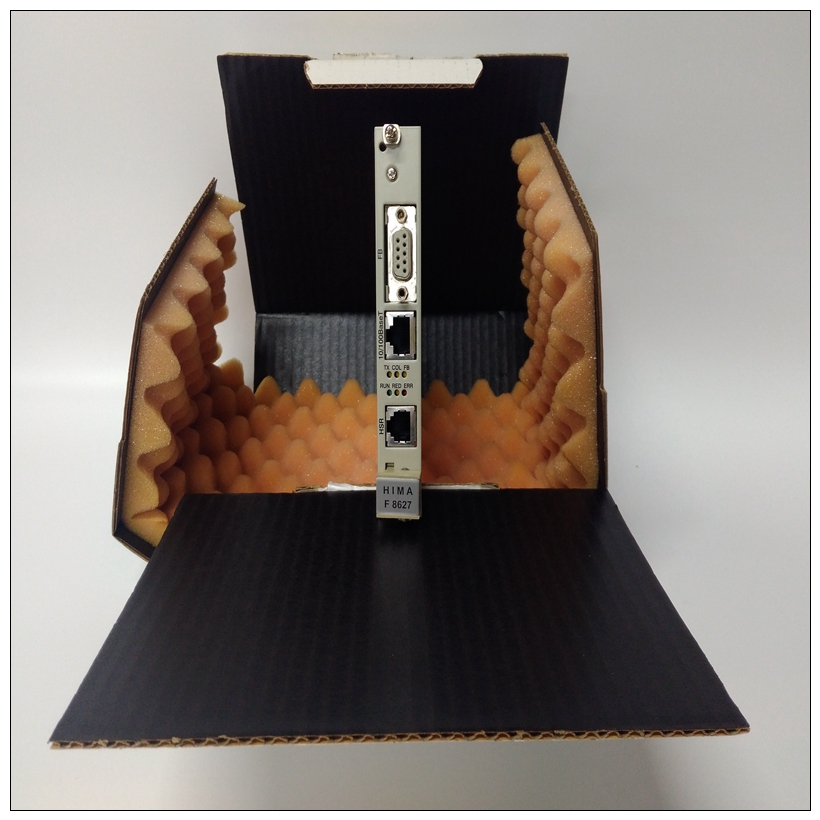HIEE450880R1脉冲输入卡件,工业卡件
例如,如果在故障报告启用菜单中将低报警启用设置为禁用,则当通道上检测到低报警时,低报警故障不会记录在I/O故障表中。故障报告启用如果启用了故障报告,下面列出的其他参数可用于启用特定类型的故障。禁用中断启用禁用低报警启用禁用高报警启用禁用低范围启用禁用超范围启用禁用断线启用(仅限电流模式)禁用下钳位报警启用禁用上钳位报警禁用短路启用(仅限于电压模式)禁用PACSystems*RX3i系统手册第12节GFK-2314T 2019年9月模拟输出模块48310.4.5.3.1报警和故障报告-诊断报告启用、故障报告启用和中断启用配置参数可用于为单个通道报警启用不同类型的响应。默认情况下,在每个通道上禁用所有响应。可以为每个通道配置报警启用的任何组合。▪ 如果启用了诊断报告,模块将在为该通道配置的诊断参考地址的参考存储器中报告通道报警。▪ 如果启用了故障报告,则模块会在I/O故障表中记录每次通道报警的故障日志。▪ 如果启用了中断,警报可以触发应用程序中中断块的执行,如下所述。10.4.5.3.2使用中断为了正确配置I/O中断,必须在该模块的配置文件中设置中断启用位。此外,应响应信道中断而执行的程序块必须映射到对应于该信道的参考地址。示例:在此示例中,输出参考地址块映射到%AQ0001-%AQ0008。如果通道2出现高报警条件,应触发I/O中断块。▪ 配置高报警条件。▪ 在模块配置中设置通道2的高报警中断启用标志。通道2的参考地址对应于%AQ00003(每个通道2个字),因此应为“I/O中断”类型设置中断程序块调度属性,并将“%AQ0003”设置为触发器。故障报告和中断这些模块具有诊断报告和中断的单独启用/禁用选项。通常,禁用配置中的诊断(如低/高报警或过高/过低范围)意味着其诊断位从未设置。但是,如果为某个条件启用了中断并且发生了该中断,则在I/O中断块逻辑执行期间也会设置该条件的诊断位。下一次PLC输入扫描总是将此中断状态位清除回0,因为诊断报告已禁用。10.4.6模块数据:IC695ALG008模块从其配置的输出字接收其信道数据,从其分配的信道值参考地址开始。每个信道占用两个字(无论是否使用信道):PACSystems*RX3i系统手册第12节GFK-2314T 2019年9月模拟输出模块484信道值参考地址包含此输入+0、1信道1+2、3信道2+4、5信道3+6、7信道4+8、9信道5+10、11信道6+12、13信道7+14、15信道8取决于其配置的信道值格式,每个启用的通道输出参考位置被读取为32位浮点或16位整数值。在16位整数模式中,32位通道数据区的低位字包含16位整数通道值。32位中的高位字(高位16位)被忽略。全系列的
For example, if Low Alarm Enable is set to Disabled in the Fault Reporting Enable menu, the Low Alarm fault is not logged in the I/O Fault Table when Low Alarm is detected on the channel. Fault Reporting Enable If Fault Reporting is enabled, the additional parameters listed below can be used to enable specific types of Faults. Disabled Interrupts Enable Disabled Low Alarm Enable Disabled High Alarm Enable Disabled Under Range Enable Disabled Over Range Enable Disabled Open Wire Enable (current mode only) Disabled Lower Clamp Alarm Enable Disabled Upper Clamp Alarm Enable Disabled Short Circuit Enable (voltage mode only) Disabled PACSystems* RX3i System Manual Section 12 GFK-2314T Sept. 2019 Analog Output Modules 483 10.4.5.3.1 Alarming and Fault Reporting The Diagnostic Reporting Enable, Fault Reporting Enable, and Interrupt Enable configuration parameters can be used to enable different types of responses for individual channel alarms. By default, all responses are disabled on every channel. Any combination of alarm enables can be configured for each channel. ▪ If Diagnostic Reporting is enabled, the module reports channel alarms in reference memory at the Diagnostic Reference address configured for that channel. ▪ If Fault Reporting is enabled, the module logs a fault log in the I/O Fault table for each occurrence of a channel alarm. ▪ If Interrupts are enabled, an alarm can trigger execution of an Interrupt Block in the application program, as explained below. 10.4.5.3.2 Using Interrupts To properly configure an I/O Interrupt, the Interrupt enable bit or bits must be set in the configuration profile of this module. In addition, the program block that should be executed in response to the channel interrupt must be mapped to the reference address corresponding to that channel. Example: In this example, the Output Reference Address block is mapped to %AQ0001-%AQ0008. An I/O Interrupt block should be triggered if a High Alarm condition occurs on Channel 2. ▪ Configure the High-Alarm condition. ▪ Set the High-Alarm Interrupt Enable flag for Channel 2 in the module configuration. The reference address of Channel 2 corresponds to %AQ00003 (2 Words per channel), so the interrupt program block Scheduling properties should be set for the "I/O Interrupt" Type and "%AQ0003" as the Trigger. Fault Reporting and Interrupts These modules have separate enable/disable options for Diagnostic Reporting and Interrupts. Normally, disabling a diagnostic (such as Low/High Alarm or Over/Under range) in the configuration means that its diagnostic bit is never set. However, if interrupts are enabled for a condition and that interrupt occurs, the diagnostic bit for that condition is also set during the I/O Interrupt block logic execution. The next PLC input scan always clears this interrupt status bit back to 0, because Diagnostic Reporting has it disabled. 10.4.6 Module Data: IC695ALG808 The module receives its channel data from its configured output words, beginning at its assigned Channel Value Reference Address. Each channel occupies two words (whether the channel is used or not): PACSystems* RX3i System Manual Section 12 GFK-2314T Sept. 2019 Analog Output Modules 484 Channel Value Reference Address Contains this Input +0, 1 Channel 1 +2, 3 Channel 2 +4, 5 Channel 3 +6, 7 Channel 4 +8, 9 Channel 5 +10, 11 Channel 6 +12, 13 Channel 7 +14, 15 Channel 8 Depending on its configured Channel Value Format, each enabled channel output reference location is read as a 32-bit floating-point or 16-bit integer value. In the 16-bit integer mode, low word of the 32-bit channel data area contains the 16-bit integer channel value. The high word (upper 16-bits) of the 32-bits is ignored. The full range of













